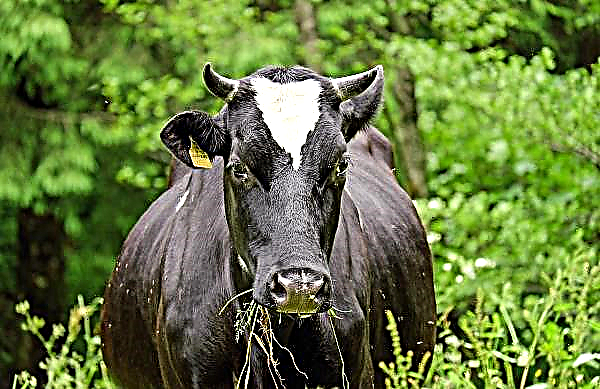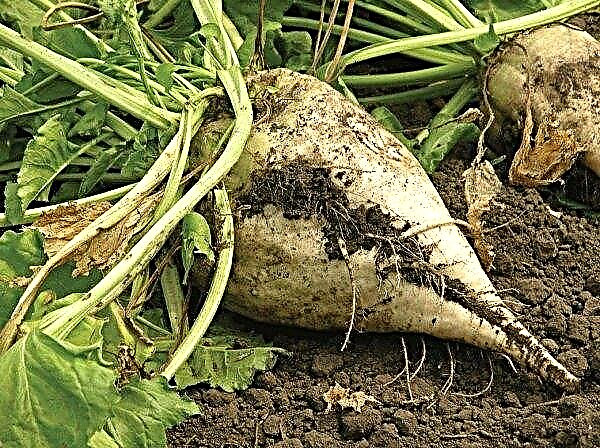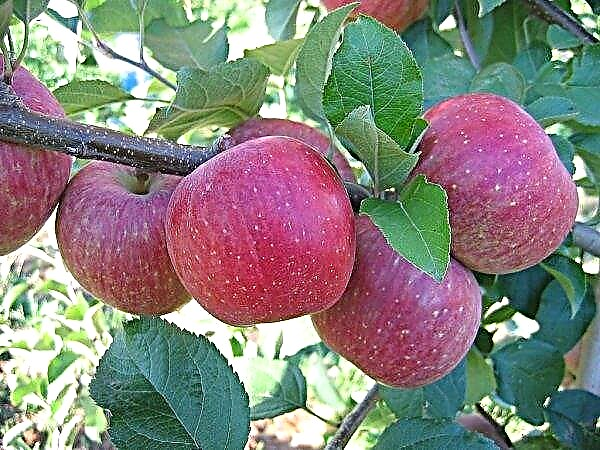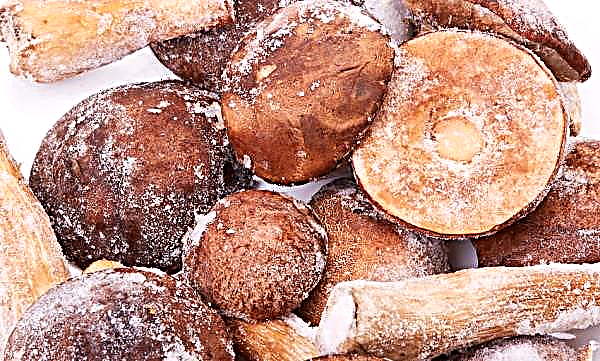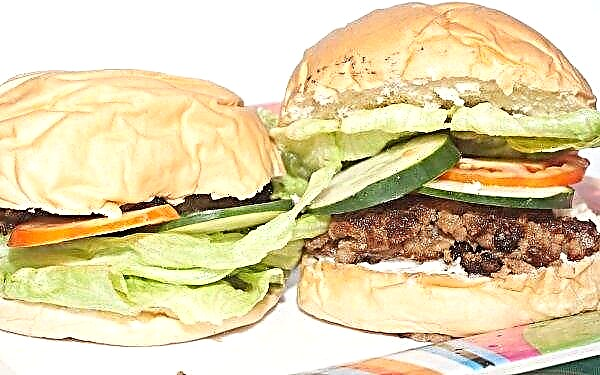Late blight is one of the most dangerous diseases that affects plants of various families. For solanaceae, this problem is very acute, and tomatoes suffer first of all. Long-term experience of gardeners allows us to determine effective folk remedies for control and prevention, which you can use on your site.
Reasons for the appearance
The disease causes a fungus called late blight. It affects all parts of the bush: the stem, leaves and fruits, and also continues to exist on green tomatoes harvested for ripening. Late blight can reduce productivity by up to 70%.
The main reasons for the appearance are:Did you know? The fungus has a significant name: translated from the language of the ancient Greeks, "late blight" means "fatal to the plant."
- fungus transfer from infected beds, such as potatoes.
- infected seeds, tubers and plant debris;
- contact with infected garden tools;
- thickened beds and weak bushes;
- the presence of fungal spores on the walls of the greenhouse.

To penetrate the fungus, moisture is necessary, therefore, increased humidity is a favorable factor in the development of the disease. The temperature of 15–20 ° С and its sharp fluctuations day and night, which lead to abundant dew on the bush itself, also contribute to this. The onset of heat and drought can stop late blight.
The first signs of late blight on tomatoes
The incubation period of late blight is from 3 to 16 days.
The initial stage of the disease is easy to miss, and it develops as follows:
- brown or gray-brown spots form and quickly spread on foliage and stems;
- the lower part of the leaf and the stem are covered with a whitish fluffy coating;
- the fruits are covered with dark spots, deformed.

In the initial stage, the fruits retain their hardness, but then begin to rot and soften. In the process of decay, an unpleasant recognizable odor appears.
The fight against late blight on tomatoes with folk remedies
Folk remedies are suitable for a small area in the initial period of late blight development. Their use is safe and has no restrictions on the fruit ripening period.
For cooking, inexpensive components are used that are available for each gardener.Important! It is recommended to change the composition of the mixture for the treatment and prevention of late blight every year, since the fungus can adapt.
Whey or kefir
Solutions based on serum and kefir are one of the most common. You can apply them daily, including for the prevention of infection. Kefir spray can be prepared in two ways.
First option:
- mix 10 liters of water and 1 liter of kefir;
- leave the mixture for 2 days.
- mix a liter of kefir and a bucket of water;
- add 20–25 drops of iodine.
- a liter of whey mixed with 9 liters of water;
- add 2 ml of iodine.

The first time you spray the plants should be two weeks after transplanting seedlings to a permanent place. A mixture with iodine can be used 2 times a month.
Any sprayer is suitable for spraying. In the greenhouse, you can spray plants on any day, and in the open field you need to choose windless and dry. If precipitation occurs the next day, spraying should be repeated.
Soda and salt
Salt spraying is a preventive measure, so the affected parts of the plant must be removed in advance.
The proportions of the solution are as follows:
- 10 liters of water;
- 1 cup of salt.

To keep the soda mixture well on the leaves, you need to add a “sticky” component:
- half a bucket of water mixed with 1 tbsp. a spoon of soda;
- pour a little liquid soap.
Vinegar
To prepare the mixture, table vinegar with an acid concentration of 9% is suitable. Add half a glass of vinegar to a bucket of water and spray the bush. Acetic treatment recommends alternating with other means of control and prevention.

Toothpaste
The original method of processing tomato is based on the bactericidal action of the components of the paste. The contents of the tube are thoroughly mixed in a small part of 1 bucket of water, and then diluted with the rest of the liquid. This method also relates more to preventive measures, and the conditions for its use in open and closed ground coincide with the basic rules for spraying.
Garlic tincture
Another traditional and popular folk method is characterized by a large number of recipes.
In early summer, a prophylactic solution is prepared from fresh arrows of winter garlic:
- Pour 200 g of arrows chopped by a blender with 10 liters of water heated to 40 ° С;
- infuse the mixture for 2 hours and strain.
Video: Processing tomatoes from late blight with garlic infusion
Another recipe:
- chop 150 g of garlic and about 300 g of garlic leaves, arrows and husks;
- add 10 liters of water;
- leave the mixture for a day, then strain.
You can also prepare the concentrate once, and then dilute it with water before each spraying. To do this:Did you know? A certain preventive effect can be achieved by joint planting of garlic and tomatoes.
- chop ½ kg of whole heads of garlic (with husk);
- pour garlic ½ liter of water in a glass container;
- close with a lid and leave in warm and dark for 8–9 days;
- strain and store in a dark place tightly corked.
Ash
Spraying with ash is carried out three times: a week after transplanting, before flowering and immediately after setting the first tomatoes.

The mixture is prepared as follows:
- half a bucket of ash is mixed with 10 liters of water;
- insist the solution for 3 days, stirring it from time to time;
- Bring the solution to 30 liters and add 30–35 g of soap for sticking.
Yeast
Yeast mixtures can be used as prophylaxis during the appearance of the first ovaries, and also treated at the first signs of late blight.

The mixture is prepared as follows:
- 100 g of yeast mixed with a bucket of warm water;
- insist for about an hour and immediately water the plants.
Hay protection
Mulching shrubs with hay creates a barrier between the plant and moist soil, stopping the possible movement of spores from the ground. In addition, the frequency of watering is reduced, and therefore, the overall moisture around the plant is reduced. Such mulching is also necessary in the greenhouse.
Hay can also save tomatoes from morning dew in the open.Important! Mulching is carried out immediately after planting seedlings and only dry hay is taken - freshly cut grass is not suitable.
Prevention measures using folk remedies
To minimize the risk of late blight infection, the following alternative methods are recommended:
- presowing seed treatment with potassium permanganate for 30 minutes in 1% solution;
- watering plants with a weak solution of manganese, throughout the growing season once a week;
- fumigation of the greenhouse with coals and a flap of natural wool. A smoky greenhouse should stand tightly closed for a day;
- piercing the stem with a thin copper wire, suitable for strong adult bushes.
Video: Prevention and methods of combating late blight on tomatoes
Is it possible to eat tomatoes infected with late blight?
Even diseased plants can give some harvest, and the question of its use excites many economical owners. There is no scientific evidence of the health hazards of late blight infected vegetables. Affected portions of tomatoes can be cut off, and apparently healthy areas can be used as food. The most cautious people can be recommended to conduct heat treatment of such fruits: cook soup or make sauce.
Affected tomatoes should not be used for conservation, since bacteria and other microorganisms can grow due to additional acidity.

Additional recommendations
It is possible to reduce the likelihood of late blight spread by reasonable site planning, as well as proper agricultural technology:
- it is necessary to observe the principles of crop rotation and not to plant tomatoes after other solanaceous crops;
- do not thicken the landing;
- Do not water the plants on a cloudy day;
- airing should be carried out regularly in the greenhouse;
- grow late blight hybrids.
Using folk remedies for the prevention and treatment of the initial stage of late blight, it is possible to ensure the safe protection of tomatoes in the garden. A wide selection of recipes and active ingredients allows everyone to choose the right composition.



